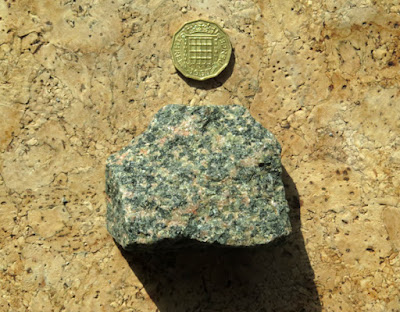The final stop on my trip to Charnwood Forest, with Paul May of the Sheffield U3A Geology Group, was at the Altar Stones Nature Reserve, which is situated a few hundred metres north of the Hole Hill Quarry Nature Reserve car park.
 |
| A view from the path leading to the layby |
The reserve occupies less than 4 hectares of a ridge of high ground, sometimes obscured by thick clumps of gorse, which the geological map shows to be formed by a small elliptical inlier of rocks of the Precambrian Maplewell Group surrounded by Triassic mudstones.
 |
| An outcrop of the Bradgate Formation |
Along the top of the ridge, which provides good views of the surrounding countryside, numerous outcrops of jagged rocks dip steeply to the south-west and, becoming progressively younger to the north-east, comprise volcaniclastic sediments of the Bradgate Formation, the Sliding Slump Breccia, the Beacon Hill Formation and the Park Breccia.
 |
| Outcrops of the Bradgate Formation |
The Bradgate Formation, which we had already seen on the top of Billa Barra Hill, was easily recognisable from its well bedded, fine grained and dense nature and its tendency to form solid angular landforms, but the surface of the rock is covered in lichens and its colour is not obvious.
 |
| A sample from the Bradgate Formation |
Examining a couple of specimens with fresh surfaces, which I had found lying on the ground, there is distinct green colouration due to the abundance of the mineral chlorite, which is very common in metamorphosed volcaniclastic sediments, and graded bedding can be clearly seen.
 |
| Another sample from the Bradfield Formation |
Both of the specimens display weakly developed cleavage and one of them contains veins of banded quartz and dark green hornblende, with some pink colouration, which I assume is related to the intrusion of markfieldite at the nearby Hill Hole Quarry.
 |
| An outcrop of volcaniclastic breccia |
We had no time to systematically examine the various outcrops and I just wandered around to take a few general photographs; however, although I couldn’t assign them to a particular rock formation, many of the outcrops are knobbly and not obviously controlled by well defined bedding planes or the regional pattern of jointing.
 |
| A detail of breccia |
A close inspection reveals that these are composed of a jumbled mass of irregularly sized and shaped clasts, which are obviously one of the breccias. These were formed by underwater landslides, generated by earthquakes, and consist of rafts of partially lithified sediment.
 |
| A general view |
Other outcrops are very ragged in nature and consist of needle like blocks pointing to the skyline, which contrast with the forms of those described above, but I didn’t examine any of them closely using my hand lens.
 |
| A general view |
Having last visited Charnwood Forest as a geology undergraduate, when we explored the area around Beacon Hill, I was pleased to see some wild Precambrian rocks again and, if the weather was dry, Altar Stones Nature Reserve would be a great place to have lunch.
 |
| A general view |
At the end of the day, we both thought that the geological content of the walk had been a little bit disappointing, partly due to the lack of access to the markfieldite quarries in the morning after a lot of effort made, and that we would have to reorganise our itinerary accordingly.
 |
| A general view |










































